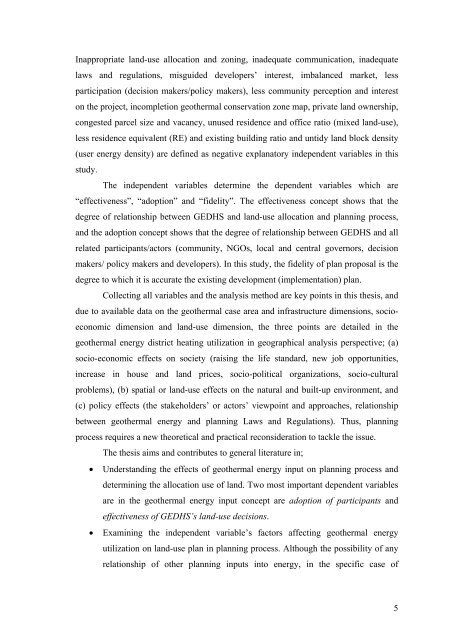developing a strategic decision-making process for local energy ...
developing a strategic decision-making process for local energy ...
developing a strategic decision-making process for local energy ...
You also want an ePaper? Increase the reach of your titles
YUMPU automatically turns print PDFs into web optimized ePapers that Google loves.
Inappropriate land-use allocation and zoning, inadequate communication, inadequate<br />
laws and regulations, misguided developers’ interest, imbalanced market, less<br />
participation (<strong>decision</strong> makers/policy makers), less community perception and interest<br />
on the project, incompletion geothermal conservation zone map, private land ownership,<br />
congested parcel size and vacancy, unused residence and office ratio (mixed land-use),<br />
less residence equivalent (RE) and existing building ratio and untidy land block density<br />
(user <strong>energy</strong> density) are defined as negative explanatory independent variables in this<br />
study.<br />
The independent variables determine the dependent variables which are<br />
“effectiveness”, “adoption” and “fidelity”. The effectiveness concept shows that the<br />
degree of relationship between GEDHS and land-use allocation and planning <strong>process</strong>,<br />
and the adoption concept shows that the degree of relationship between GEDHS and all<br />
related participants/actors (community, NGOs, <strong>local</strong> and central governors, <strong>decision</strong><br />
makers/ policy makers and developers). In this study, the fidelity of plan proposal is the<br />
degree to which it is accurate the existing development (implementation) plan.<br />
Collecting all variables and the analysis method are key points in this thesis, and<br />
due to available data on the geothermal case area and infrastructure dimensions, socioeconomic<br />
dimension and land-use dimension, the three points are detailed in the<br />
geothermal <strong>energy</strong> district heating utilization in geographical analysis perspective; (a)<br />
socio-economic effects on society (raising the life standard, new job opportunities,<br />
increase in house and land prices, socio-political organizations, socio-cultural<br />
problems), (b) spatial or land-use effects on the natural and built-up environment, and<br />
(c) policy effects (the stakeholders’ or actors’ viewpoint and approaches, relationship<br />
between geothermal <strong>energy</strong> and planning Laws and Regulations). Thus, planning<br />
<strong>process</strong> requires a new theoretical and practical reconsideration to tackle the issue.<br />
The thesis aims and contributes to general literature in;<br />
• Understanding the effects of geothermal <strong>energy</strong> input on planning <strong>process</strong> and<br />
determining the allocation use of land. Two most important dependent variables<br />
are in the geothermal <strong>energy</strong> input concept are adoption of participants and<br />
effectiveness of GEDHS’s land-use <strong>decision</strong>s.<br />
• Examining the independent variable’s factors affecting geothermal <strong>energy</strong><br />
utilization on land-use plan in planning <strong>process</strong>. Although the possibility of any<br />
relationship of other planning inputs into <strong>energy</strong>, in the specific case of<br />
5
















